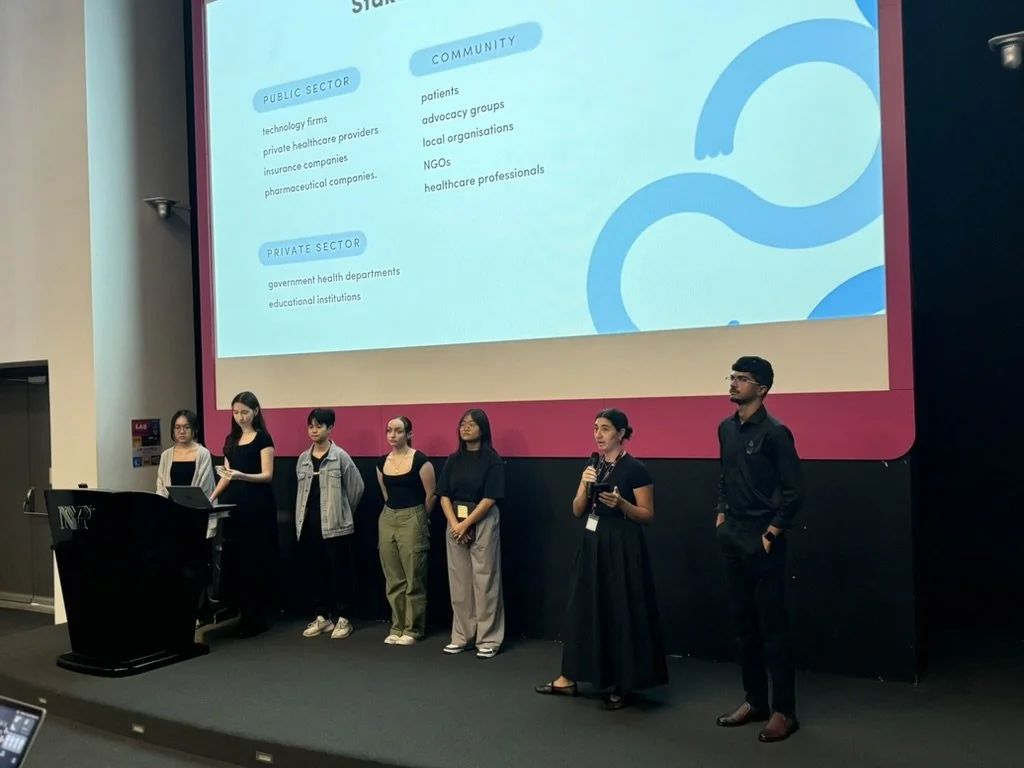Design for Change: Sustainability in Healthcare
2024 | QUT Study Tour | Digital System
In July of 2024 I participated in the Design for Change Study Tour to Malaysia and Singapore with Queensland Univeris. The tour consisted nine different universities collaborating for symposium and design sprint.
Throughout the tour we were able to visit and experience many different cultural sites and see the rich culture that both Malaysia and Singapore have to offer.
The tour began at Taylor’s University in Malaysia for the symposium. During we had the privilege of listening and learning from a range of industry experts, from doctors, nurses, design professionals, regulatory experts.
During the next week, we travelled to Singapore to Nanyang Polytechnic University for a design sprint. During this time we had a week to research, ideate, and design our solution for better sustainability in healthcare in Malaysia and Singapore.
Get in Touch
Along side my multidisciplinary team members, we built 👋💻Get In Touch, a multilingual AI speech and image translator to make practitioner to patient communication more efficient and empathetic.
The Situation
It is challenging for patients (elderly, mothers, migrant workers, etc) to understand their diagnosis, treatment and medications due to the lack of effective communication (E.g Mental or physical factors - language, less educated, vision, hearing loss, cognitive decline, disease related illnesses) provided by the hospital.
It is difficult for doctors to provide post procedure care instructions, including any necessary medications, activities restriction and follow up appointments, communication is a two-way process where information is not conveyed across to patients or doctors don't understand patients needs.
Team Members
Gracie Lee (QUT)
Sameer Asim Khan (MBRU)
Jasmine Gagliano (UTS)
Ke Xuan Lim (NYP)
Ten Sze Ching (Taylors)
Hong Yuet Ling (NYP)
How Might We…
How might we establish effective communication tools to meet patients needs and support them throughout their recovery journey?
How can we improve verbal doctor to elderly patient communication for diverse language and cultural contexts during care?
Increase medical adherence and condition understanding?
Reduce re-admissions and unnecessary resource utilisation?
Research
During the design sprint we visited a Hospital and nursing home to interview patients and healthcare staff. As a team we created interview questions and had topics we wanted to discuss with staff and patients, although we wanted to leave room to let the interviewees lead the discussion.
User Personas
Potential Beneficiaries
Healthcare Admin 👩⚕️
Insurance Companies 🩺
Limitations and Next STeps
Direct Beneficiaries
Patient 😷
Nurse and Doctor 🧑⚕️
Ideation
As a team we brainstormed and ideated upon our research, problem task and symposium information.
During this process we identified key stakeholders within the healthcare system.
Indirect Beneficiaries
Caregivers 👨👩👧👦
Hospitals 🏥
After research and interviews we collated all out information into pain points within the system, sympathy maps, user personas and outlined the exact problem we wanted to tackle.
The Problem
Language barriers and complex medical concepts hinder patients’ understanding of their treatment plans, leading to increased time costs, miscommunication and poorer health outcomes.
Observations
Our Solution
A multilingual AI speech and image translator to make practitioner to patient communication more efficient.
Key themes: Empathy, Efficiency, Seemlessness, Sustainability, Education.
Journey Map - Hospital Visit
Annotated UI
Our Final Banner for presenting
Language and cultural barriers - Singapore vs International
Train the AI for different dialects/cultures
Observations in elderly care home + women’s hospital vs other healthcare settings
Different health facilities have different tech requirements
Privacy for AI and health data
Sign language and disabilities
Only real-time care - no pre or post
UI and UX testing
Reflection on my role
In this project, I took on the role of interaction designers, which required both collaboration and technical skills. I focused on user experience, user research, user interface design development and ensuring the design aligned with the projects problem statement and goals.
One of the challenges I faced was collating a mass amount of research and many different problems within the problem space. To address this I aimed to keep our solution simple and straightforward, keeping in mind that not every project can solve all the problems. I sort out regular feedback sessions on our research and design from both medical and design experts.
Through this process, I developed stronger research skills such as interviewing and user experience design. Additionally I expanded upon my presentation skills during our pitch. Both of these skills I believe contributed significantly to the project’s success. Reflecting on this experience, I am proud of our final design and its potential impact of the healthcare system and multilingual communication.
Lastly, this project wouldn’t have been possible without the amazing skillset, collaboration and dedication of my team members, who worked incredibly hard over the week long design sprint.
Award Recognition
For Get In Touch, my team was honoured with the Pitch Award, in recognition of our teams presentation and project solution. The pitch was delivered at Nanyang Polytechnic University at the end of the design sprint. It was award to us during an exhibition of our final banner at Raffles House in Singapore alongside all the other design sprint teams.


























